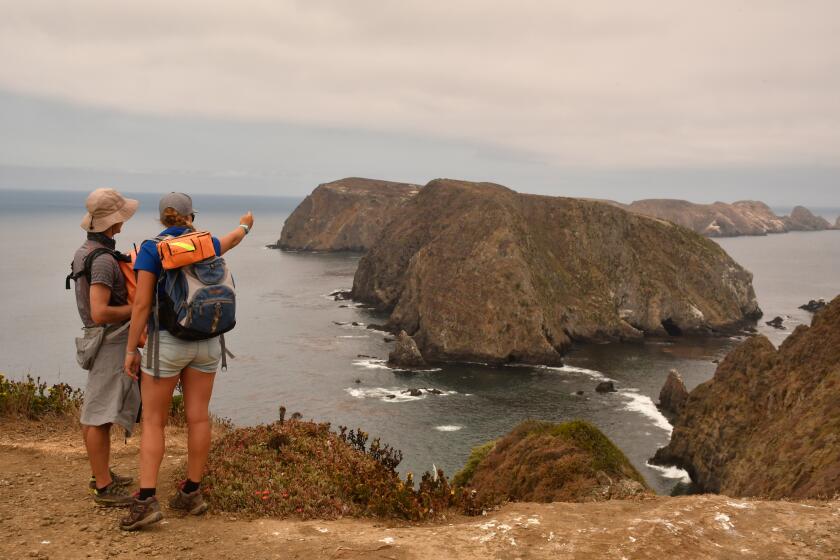Profiting From a Public Resource
- Share via
Water rights are not property rights. Yet throughout California, they are being treated as if they were.
The California Constitution declares that water belongs to all of the people. Water rights convey the privilege of using water, not owning it, and only if the water is used for “reasonable and beneficial” purposes. In other words, the privilege is conditional on not being wasteful.
Our water bills cover the cost of moving water from where it is found to where it is used. We pay for canals, pumps, pipelines and management services. Most of the facilities have been built at public expense.
Yet water sales from willing sellers to willing buyers are euphemistically called “water transfers” and wasteful practices go unchallenged as we struggle to resolve our water future. Water transfers have been almost universally accepted as the best, most equitable way to reallocate this precious resource--regardless of their true equity or long term social, economic or environmental impacts.
More than 80% of developed water in the state is used by agriculture. The low cost of most agricultural water gives growers little or no incentive to use water efficiently. The rule is “use it or lose it,” for if water is not used, the right to it is threatened. But it is OK to sell unused allocations and profit from the sale.
Historically, transfers have taken place between farmers, typically within the same irrigation district; profit has not been the motive. What is now proposed and beginning to happen are sales from agribusiness water districts to urban water agencies, where profit is most definitely the motive.
Why is no one publicly challenging the sale of this water, allowing growers to profit from facilities built with tax dollars? Why is no one examining the public interest in such sales?
Just as the issue of farmers benefiting from public investment has been avoided, no one is seriously talking about determining just how much water is really needed and where to meet our economic, social and environmental needs.
Twenty-five years ago, the electrical industry was projecting energy usage compounding at 7% a year, doubling in 10 years. This led to predictions of a nuclear power plant every 50 miles along the coast of California. It was this prospect that led to the formation of the state Energy Resources, Conservation and Development Commission, which was given the job of predicting real demand, after considering all cost-effective efficiencies. As a result, not a single new power plant has since been built in California, and consumers are getting stuck with paying for “stranded investments” such as old nuclear power plants no longer needed or unable to compete on the open market.
The water industry now finds itself in similar circumstances and also is unwilling to discipline itself. Money is made from selling water, not from conserving it. Water industry executives pray for dry weather because then they sell more water. Few water agencies, especially in Northern California, are serious about making efficient use of what we have or in reclaiming water for reuse, though there are signs that attitudes are beginning to change.
Here in Southern California, while the Metropolitan Water District does have incentive programs to encourage conservation and reuse, not all of its member agencies take advantage of them.
The State Water Resources Control Board has the authority and the obligation to do for water what the energy commission has done for electric power. The CalFed Bay-Delta Program, a cooperative state and federal effort to repair the damage to the San Francisco Bay Delta watershed from generations of abuse as well as to meet future water needs, could also enforce more efficient water use for most of the state. But the political will to enforce efficiencies does not exist.
The politics of water is heavily influenced by those in the water community who contribute to election campaigns--big agriculture. Farmers have always been independent folks, resenting anyone telling them what to do. Just as they refuse to manage their ground water reservoirs so that wet year surpluses can be stored underground against dry year need, so many of them give halfhearted lip service to irrigating efficiently. Using less water, of course, would threaten their water rights--unless they could sell any surplus for profit.
For instance, Arvin Edison, a major agricultural contractor for San Joaquin River water, is proposing to sell 450,000 acre-feet of water to the overwhelmingly urban Metropolitan Water District--completely beyond Arvin Edison’s own area.
Something is wrong with this picture. We need to take a whole new look at the meaning of water rights and base the allocation of our precious water resources on true need, not on historic usage. How to accomplish this is the dilemma facing our water future. California has ample water to meet all its environmental, social and economic needs, if we can find a way to allocate it more rationally.
More to Read
Sign up for Essential California
The most important California stories and recommendations in your inbox every morning.
You may occasionally receive promotional content from the Los Angeles Times.













